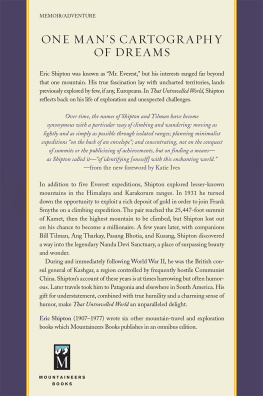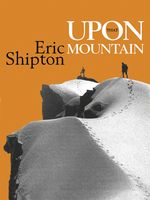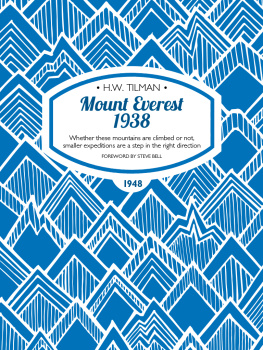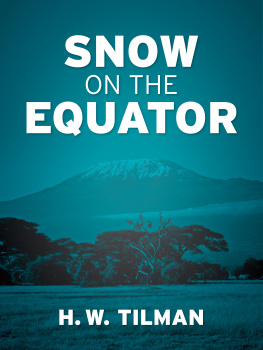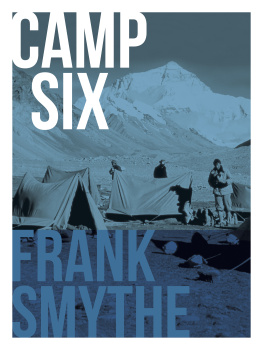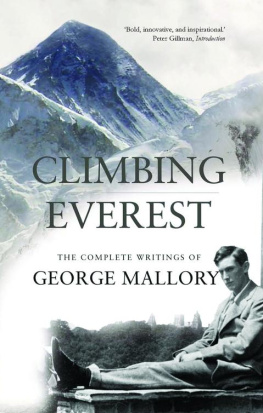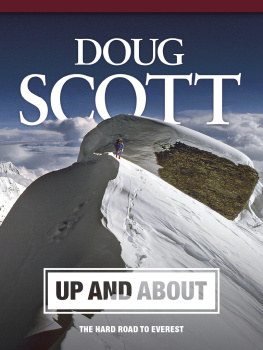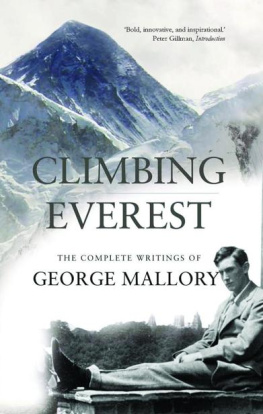THAT UNTRAVELLED WORLD


THAT UNTRAVELLED WORLD

AN AUTOBIOGRAPHY
ERIC SHIPTON
Foreword by
KATIE IVES
LEGENDS AND LORE SERIES


Mountaineers Books is the publishing division of The Mountaineers, an organization founded in 1906 and dedicated to the exploration, preservation, and enjoyment of outdoor and wilderness areas.
1001 SW Klickitat Way, Suite 201 Seattle, WA 98134
800.553.4453 www.mountaineersbooks.org
Copyright 1969 by Eric Shipton
Foreword copyright 2015 by Katie Ives
All rights reserved. No part of this book may be reproduced or utilized in any form, or by any electronic, mechanical, or other means, without the prior written permission of the publisher.
Printed in the United States of America
18 17 16 15 1 2 3 4 5
Layout: Emily Ford
Series design: Karen Schober
Cover photograph: Eric Shipton at the top of Peak 21120 during 1935 Everest Reconnaissance Expedition
Royal Geographic Society (with IBG)
Frontispiece: Portrait of Eric Shipton Royal Geographic Society (with IBG)
All photographs by Eric Shipton unless otherwise credited.
Library of Congress Cataloging-in-Publication Data
Shipton, Eric, 1907-1977.
The untravelled world : an autobiography / by Eric Shipton ; foreword by Katie Ives ; Line Illustrations by Biro.
pages cm
Includes index.
ISBN 978-1-59485-897-0 (trade paper)ISBN 978-1-59485-898-7 (ebook)
1. Shipton, Eric, 1907-1977. 2. MountaineersBiography. I. Title.
GV199.92.S53A35 2015
796.522092dc23
[B]
2014032091
Printed on recycled paper

ISBN (paperback): 978-1-59485-914-4
ISBN (ebook): 978-1-59485-915-1
CONTENTS
THE REENCHANTED WORLD
IN OCTOBER 1928, A YOUNG British man stepped out of a bungalow at sunrise. Beyond the vast and shadowed plains, the twin summits of Mount Kenya rose through layers of lilac haze, sharpening into a crystalline tower. Sunlight glittered across jewel-like patches of ice. It was the first morning of his apprenticeship on a coffee farm in Nyeri, Kenya, then part of the British Empire. Already, he felt enchanted. In the evening, he waited for the mist to fade and the peaks to reemerge in fragments of ice gullies and gilded artes. In the brief tropical twilight, Eric Shipton recalls in his autobiography, That Untravelled World, the revelation was always fleeting.
After the death of his father, who had been a tea planter in Ceylon, Shipton had spent his early years travelling in Europe and British India with his restless mother and older sister. When the family settled in London, he found the routines of urban life to be grey and dull. Taking refuge in adventure books, he conjured up vague dream worlds of strange lands that glowed and shifted like the images of a magic lantern: the pale expanses of the Arctic, the green rings of Pacific atolls, and the chaotic sweep of glaciers. During adolescence, he learned to climb in the Alps, and he realized that mountaineering might become a focus for [his] vague longing for contact with wild country.
Not long after his first glimpse of Mount Kenya, Shipton and his climbing partner Percy Wyn-Harris reached the mountains dual summits, making a first ascent of the rocky spire of Nelion. In 1930 Shipton returned to complete a traverse of the peaks, accompanied by another British coffee planter, Bill Tilman. It was the start of one of the most famous friendships in mountaineering history. The two men went on to explore numerous unclimbed peaks in the Himalaya together, roaming through unmapped regions during an era when few mountaineers had ventured above 25,000 feet. Over time, their names became synonymous with a particular way of climbing and wandering: moving as lightly and as simply as possible through isolated ranges; planning minimalist expeditions on the back of an envelope; and concentrating, not on the conquest of summits or the publicizing of achievements, but on finding a meansas Shipton called itof identifying [oneself] with this enchanting world.
Bob A. Schelfhout-Aubertijn, a Dutch collector of mountaineering books, once declared: Of course new and fascinating tales and heroic or tragic stories are being written, even as we speak. Recent adventures that will become classics. But with the older ones, it is as if time has added some kind of patina, a mystique that takes a number of decades and adds a certain charm. For many readers of alpine literature, the mere thought of Shiptons work can summon up vast worlds of lost time: the sighting of purported Yeti footprints near the glacial basin of Snow Lake; the discovery of the hidden passage along the cliffs and ledges of the narrow Rishi Gorge to the Nanda Devi Sanctuary; the crossing of Patagonias immense, windswept continental icecap; or the vision of ice blocks crashing soundless down the north face of K2, long before the mountain was climbed, in an epoch when only a handful of mountaineers had even seen it from that side.
It is one of Shiptons quieter moments that I imagine most. On a 1937 Karakoram expedition, while he lay on the sandbanks of a clear stream in the Shaksgam Valley, far from any inhabited place, he watched as the dusk turned the desert summits into ghostly shadows and the stars seemed to flow across the darkening heavens. How satisfying it was to be travelling with such simplicity, he writes in Blank on the Map. Did I sleep that nightor was I caught up for a moment into the ceaseless rhythm of space? On late evenings, wandering alone in other lands and ranges, I have felt a similar blurring of snow, ice and sky. Walking across a barren steppe before dawn or climbing frozen waterfalls by starlight, I have imagined myself following the arc of the Milky Way.
In a sense, the history of mountaineering is a narrative of classic tales giving rise to new adventures. Since Shiptons death in 1977, generations of climbers have been caught up in the rhythm of his prose until it echoes through adventures of their own. Throughout his long career, the Indian explorer Harish Kapadia has read and reread Shiptons and Tilmans books, adapting their back-of-the-envelope approach to his own quests for uncharted peaks and quiet valleys, seeking an intimate connection with wild lands and local myths. As a young man, the Japanese mountaineer Tamotsu Nakamura discovered a copy of Shiptons Upon That Mountain at his university alpine club. The old stories of the remote borderlands of the world helped stir Nakamuras dreams of mapping unclimbed mountains in western Sichuan and eastern Tibet. For decades now, Nakamuras photos of silvery rock walls and sharp snow crests have reminded climbers of the vast and radiant unknowns that still remain.

